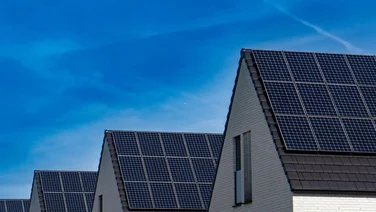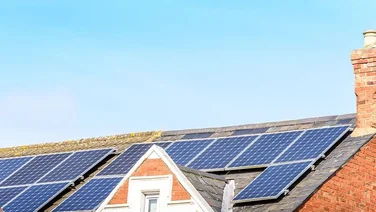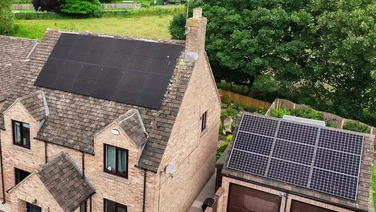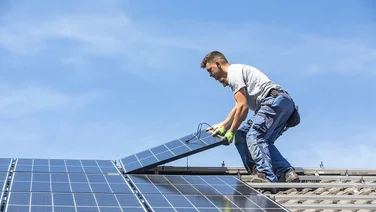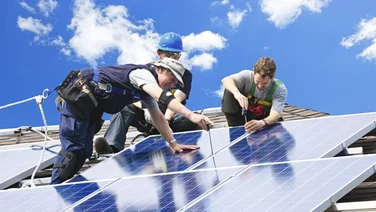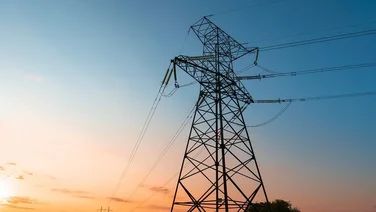- You’d need 6-8 acres of land to generate roughly 1 MWh of solar energy
- The UK’s largest solar farm, Shotwick Park in Wales, has a 72.2 MW capacity
- The best place to build solar farms is on flat land or south-facing slopes
There are currently over 1,000 solar farms in the UK, with a combined capacity of 8.67 gigawatts (GW). And that number’s set to grow, especially with solar panel costs having fallen dramatically in the past decade.
In 2022, a record number of new solar farm developments were approved in the UK – with around 4 GW of capacity being approved, compared to 3.1 GW in 2021, according to Solar Media Market Research.
That figure is set to grow in the coming years, with the Labour government betting big on renewable energy, particularly solar.
In July 2024, the government gave the go-ahead for three major solar farms which will power thousands of homes over the next 60 years.
But what exactly is a solar farm and how does it differ from a domestic solar panel installation? To help answer these questions, we’ve created a complete guide to solar farms below, outlining all the information you’ll need to understand them.
Where do you want to install solar panels?
Get started
What are solar farms?
First off, an introduction to what solar farms actually are. In short, a solar farm is functionally no different from the same solar panels you’ll find on rooftops around the world, only at a much greater scale.
When you collect large amounts of solar panels and place them in optimal locations, the potential for generating electricity increases immensely. This can then be used to power villages and towns, all the way up to entire cities depending on the scale of the solar farm.
Take India’s Bhadla Solar Park for example. It’s the third largest solar farm in the world, with a capacity of 2.7 gigawatts (GW).
To put that into perspective, a single gigawatt has the potential to power anywhere between 200,000 to 1,000,000 homes, depending of course on how much energy each home uses.
The fact that we’ve figured out how to generate all this power just from the sun is an extraordinary feat of human ingenuity!
Want to know more about the world’s largest solar farms? Check out our page.
How do solar panels work?
The solar panels used in solar farms are made up of photovoltaic cells, which themselves are made out of silicon wafers manufactured through a process of converting beach sand into high-grade silicon.
The interconnected wafers form the photovoltaic cells and give solar panels their ability to absorb sunlight, convert it into electricity, and power our homes.
Naturally, there are other, more complicated elements involved in creating solar panels, but this is the basic gist of it.
Want to find out how much it’ll set you back to invest in solar? Head to our solar panel cost page.
Where do you want to install solar panels?
Get startedKey benefits of a solar farm
- Produces a reliable, renewable clean energy source
- Produces no further pollution after construction
- Incredibly easy to maintain
- Lets the surrounding land on a farm ‘go wild’, which is good for the environment
- Starts paying for itself once the initial investment is paid off

The different uses of solar farms
Because solar farms vary so much in scale, the different ways they can be used also vary significantly.
It all depends on what is needed, whether that be a few small-scale installations to power a village, or a large-scale (utility-scale) solar farm designed to generate electricity for an entire town or city.
Take a look below for a breakdown of the different uses of solar farms:
Community solar farms
Community solar farms are on the smaller scale. They are exactly what they sound like: a way for smaller communities to take advantage of the benefits of solar panels, without the expenditure of purchasing them outright.
Community solar farms are also great for people who might not have the property or space needed for personal installation. They would, however, need to lease nearby land, but typically a community would pool together funding for this or a council would offer a grant.
There are several examples of community solar farms in the UK, including Reach Community Solar Farm, located in Cambridgeshire. The farm was built in 2016 and generates enough energy to power around 50 houses, or around half the village.
Also built in 2016 is the Gawcott Fields Community Solar project, which is situated between Buckingham and Gawcott, and has a capacity of 4.17 MW. That’s enough to power around 1,000 homes.
Gawcott Fields uses the government’s old Feed-in-Tariff (which is now unavailable to new customers) to sell surplus electricity back to the grid, and invests the income back into the community.
Homeowners should bear in mind that this scheme is different to the Rent-a-Roof initiative, which leases your roof to energy companies so they can profit from any excess electricity generated by the solar panels.
Large-scale solar farms
Larger solar farms are often funded by institutional investors – and sometimes by governments – as the sheer cost of building them is almost always out of the reach of individuals or communities.
Large-scale solar farms usually supplement other forms of generation connected to power grids. This helps shift a community’s reliance away from fossil fuels.
However, that’s not to say a large-scale solar farm couldn’t be the only source of power for a community – and in fact, as technology improves, this is becoming more common.
It is also a growing trend for some businesses to fund their own solar farms, in a bid to reduce their energy demands. As the need for more carbon-neutral approaches increases, we expect to see more of the world’s big corporations switch to powering their businesses with solar energy.
Shotwick Park in Flintshire, Wales, is the UK’s largest solar farm. It’s operated by British Solar Renewals, and has a capacity of 72.2 MW.
It powers around 18,055 homes each year, and provides enough electricity to meet around 60% of the nearby UPM paper manufacturing plant’s energy needs.
Another large solar farm is West Raynham Solar Park in Norfolk, England, which covers 225 acres. It’s owned by the Bluefield Solar Income Fund, has a 49.9 MW capacity, and powers around 14,000 homes.
How much does a solar farm cost?
The cost of a solar farm can vary from around £500,000 for small community farms, to over £50 million for large scale solar farms.
The total cost depends first on the obvious factor: the size of the solar farm.
It costs £8,000 to £10,000 to buy one acre of land in the UK. You could fit around 4,000 solar panels on an acre, which would cost around £3 million to buy and install.
You will also have to pay additional costs for connecting your panels to the National Grid, and for maintenance.
There is more to think about than just size though, such as the average cost per watt, which is determined by things such as sunlight availability, infrastructure access, and how much the lease costs for the land (unless it’s privately owned).
You’ll also have to consider the cost of the base materials plus construction.
As for sunlight availability, if a solar farm is in a less-than-optimal location, each kilowatt hour will take longer to generate and cost more as a result. This is because of fixed costs such as maintenance payments and/or any lease payments that have to be paid.
Solar farms benefit from economies of scale, in the sense that as a solar farm gets larger, the cost per watt becomes more efficient.
On a positive note, solar is definitely shaking off its reputation for eye-watering costs. Since 2010, the cost of solar energy has dropped by more than 80%.
To read more about the costs of solar panels, check our recent guide on solar panel costs.
What is the payback period for a solar farm?
It generally takes between five to 10 years to pay back the money you’ve borrowed on a solar farm through earnings from selling electricity back to the grid.
How long it takes will depend on the type of solar panels you have, their size, how many of them there are, and the amount of sunlight they are exposed to. The larger your solar farm is, the less time this usually takes, since it will generate more electricity.
What is the minimum space needed for a solar farm?
There are no two ways about it: solar farms need space, and lots of it. To accommodate a solar farm with a capacity of 1 MW, you would need between six and eight acres.
This isn’t just for the panels though – you also need to accommodate essential equipment such as inverters and storage batteries.
You have to ensure there’s adequate space between the panels for any maintenance needed, too.
However, this process is still significantly faster than the time it takes to build conventional power stations.
Do solar farms need planning permission?
Yes, all solar farms need planning permission because of their size. In the UK, any ground mounted solar panel system that is larger than 9 square metres needs planning permission, and most solar farms are several acres.
Do solar farms make noise?
Solar panels themselves don’t make noise, but some of the additional solar equipment does. For example, inverters that convert solar energy into electricity, or storage systems make a low humming noise while they operate.
Solar farms are usually built away from built up areas in an effort to reduce noise pollution.
Where are solar farms built?
As solar farms need so much space, they are built primarily on rural land. The best spots for solar farms are either flat or south-facing slopes, where the panels can take full advantage of the sun’s peak rays.
There are even some examples of solar farms that tilt to face the sun throughout the day, such as the Benban Solar Park in Egypt.
For those looking to convert agricultural farmland, many countries (including the UK) will require planning permission. If said farmland is highly fertile, the chances of getting permission to build a solar farm are reduced.
On the other hand, desert or low-yield land, or land used only for grazing, have much higher chances of getting permission.
Lately, the idea of combining solar farms with biodiversity initiatives is becoming increasingly popular. This often means allowing the spaces between solar panels to ‘rewild’, which encourages wildflower growth and attracts bees and other insects with a host of benefits.
It’s encouraging to see that more resources are being made available to those looking to build a solar farm and improve the surrounding environment.
Some areas are also building solar farms into urban areas, which involves installing them on roof tops, unused spots, and car parks.
Other projects include combining solar farms with agricultural farms, to produce both crops and green energy. The practice is called agrivoltaic farming.
How long do solar farms take to build?
Size will of course impact build time, but broadly speaking it will only take a matter of months to complete the initial construction of a solar farm. That’s just the beginning though, as the completion of the solar farm to operating capacity can take between one and three years.
Connecting to the grid
Don’t forget that you need a connection to the power grid in order to actually use the electricity generated by your solar farm! In an ideal world, the site you pick will already have a connection, but if it doesn’t, you’ll have to pay to get one set up.
There are different types of grid connections, depending on the voltage. Small community solar farms will typically connect at low voltage.
Larger solar farms will usually connect at high voltage, which can be anything up to the 11,000 volts used by what’s known as the local distribution network.
The biggest solar farms may connect into the Transmission network, which uses the big overhead cables seen on the pylons that crisscross a country, at voltages of 130,000 or even higher.
Where are the biggest solar farms in the world?
It should come as no surprise that China dominates the global solar industry. It boasts six of the world’s biggest solar farms and has a total solar capacity of 2,919GW.
The Xinjiang Solar Farm – with a capacity of 5GW – is the world’s largest solar farm, followed by Golmud Solar Park – also in China – in second and India’s Bhadla Solar Park in 3rd.
Asian solar farms account for 12 of the biggest 15, with only the Benban Solar Park in Egypt, the Villanueva Plant in Mexico and the Francisco Pizarro farm in Spain the outliers.
Summary
While the early steps and setup involved in starting a solar farm can be challenging, it’s clear that the investment is worth it. A well-managed solar farm, even in a less-than-ideal location, will give you enormous benefits as an unlimited source of clean, renewable energy.
And as technology continues to improve, we’ll see solar farms go from strength to strength.
You’ll also improve your brand image by going green. 62% of people want the gas to be replaced with renewable energy in the UK, and your company could be part of that move.
So for businesses looking for cleaner energy sources, investing in solar farms is a no-brainer. After the initial building costs, solar farms soon start to pay back (tax credits are just one way a solar farm can be profitable).
And with green energy production on the rise across the planet, there has never been a better time to invest!


